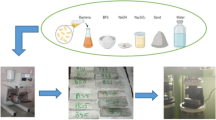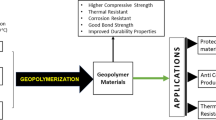Abstract
Physical and mechanical properties variations of lithium slag were systematically investigated by three different ways such as physical, chemical activation, physical-chemical combined activation. Mechanisms of the cementitious properties and hydration process of lithium slag composite cement were studied by XRD and SEM. The results showed that specific surface area increased from 254 to 700 m2/kg while median particle size decreased from 14.97 to 8.45 um with the increase of grinding time. Physical, chemical activation and combined activation improved the strength and hydration degree of lithium slag composite cement. Compared with original lithium slag, the flexural strength and compressive strength of mortars were improved significantly with the increase of grinding time. A higher strength of the cement with the lithium slag was attained; The sample with 10% lithium slag got the highest strength when the grinding time was 10 min; the compressive strength was higher than OPC at 28 days, which increased by 12.3%. When the Na2SO4 content was 0.6%, the compressive strength increased by 1.4%; when the Al2(SO4)3·18H2O content was 0.4%, the compressive strength increased by 5.8% at 28 days. Compared with the late strength, the improving degree of early strength was larger with the incorporation of activator. The results of XRD and SEM were consistent with the results of mechanical properties; it is also evident that lithium slag composite cement hydration products were mainly AFt, Ca(OH)2, CaSO4·2H2O, and C-S-H gel.
Similar content being viewed by others
References
Zhang T, Yu Q and Wei J. Efficient Utilization of Cementitious Materials to Produce Sustainable Blended Cement[J]. Cement & Concrete Composites, 2012, 34(5): 692–699
Lilkov V, Petrov O and Tzvetanova Y. Mossbauer, DTA and XRD Study of Portland Cement Blended with Fly Ash and Silica Fume [J]. Construction and Building Materials, 2012, 29: 33–41
Arizzi A and Cultrone G. Aerial Lime-Based Mortars Blended with a Pozzolanic Additive and Different Admixtures: a Mineralogical, Textural and Physical-Mechanical Study [J]. Construction and Building Materials, 2012, 31: 135–143
Beushausen H, Alexander M, Ballim Y. Early-age Properties, Strength Development and Heat of Hydration of Concrete Containing Various South African Slags at Different Replacement Ratios[J]. Construction and Building Materials, 2012, 29: 533–540
Li X, Lv Y and Ma B. Utilization of Municipal Solid Waste Incineration Bottom Ash in Blended Cement [J]. Journal of Cleaner Production, 2012, 32: 96–100
Tkaczewska E, Mróz R and Łój G. Coal-biomass Fly Ashes for Cement Production of CEM II/A-V 42.5R [J]. Construction and Building Materials, 2012, 28(1): 633–639
Wongkeo W, Thongsanitgarn P, Chaipanich A. Compressive Strength and Drying Shrinkage of Fly Ash-bottom Ash-silica Fume Multiblended Cement Mortars [J]. Materials and Design, 2012, 36: 655–662
Frías M, Sanchez de Rojas M, García R. Effect of Activated Coalmining Wastes on the Properties of Blended Cement [J]. Cement & Concrete Composites, 2012, 34(5): 678–683
Li C and Fei W. Lithium Residue Utilization in Cement Industry [J]. Cement Technology, 2001, 5: 57–58
Zhang L. Experiment Study on High-performance Lithium-slag Concrete [J]. Journal of Liaoning Technical University, 2007, 6: 877–880
Chen J. Study on Lithium Slag and Lime Stone Self-compacting High Strength High Performance Concrete [J]. Construction Technology, 2007, 4: 52–54
Zhang Y, Sun W and Yan H. Hydration of High-volume Fly Ash Cement Pastes [J]. Cement and Concrete Composites, 2000, 22(6): 445–452
Goñi S, Frias M and Vegas I. Effect of Ternary Cements Containing Thermally Activated Paper Sludge and Fly Ash on the Texture of C-S-H Gel [J]. Construction and Building Materials, 2012, 30: 381–388
Zhang T, Yu Q and Wei J. Study on Optimization of Hydration Process of Blended Cement[J]. Journal of Thermal Analysis and Calorimetry, 2012, 107(2): 489–498
Li J, Wang Z, Wang Y. Study on Reaction Dynamics of the Activated Fly Ash-cement-water System [J]. Natural Science Journal of Harbin Normal University, 2000(1): 69–73
Zhou L, Wang Z and Li J. Study on Activity Agents of Fly Ash [J]. Low Temperature Architecture Technology, 2004(2): 8–10
Khmiri A, Samet B and Chaabouni M. A Cross Mixture Design to Optimize the Formulation of a Ground Waste Glass Blended Cement [J]. Construction and Building Materials, 2012, 28(1): 680–686
Fraay ALA. Fly Ash a Pozzolan in Concrete[D]. Delft: Delft University of Technology, 1990
Liu B, Liang H and Yang Y. Alkaline Activated Fly Ash in Aement-fly Ash System [J]. Journal of railway Science and Engineering, 2009(5): 51–56
Zhong S, Ni K and Li J. Properties of Mortars Made by Uncalcined FGD Gypsum-fly Ash-ground Granulated Blast Furnace Slag Composite Binder [J]. Waste Management, 2012, 32(7): 1 468–1 472
Ogawa S, Nozaki T and Yamada K. Improvement on Sulfate Resistance of Blended Cement with High Alumina Slag [J]. Cement and Concrete Research, 2012, 42(2): 244–251
Cheng A. Effect of Incinerator Bottom Ash Properties on Mechanical and Pore Size of Blended Cement Mortars [J]. Materials and Design, 2012, 36: 859–864
Sheng G, Li Q and Zhai J. Investigation on the Hydration of CFBC Fly Ash [J]. Fuel, 2012, 98: 61–66
Author information
Authors and Affiliations
Corresponding author
Additional information
Funded partly by the National Natural Science Foundation of China (Nos. 51378408, 51408448) and State Key Laboratory of Silicate Materials for Architectures (Wuhan University of Technology) (No. SYSJJ2013-07)
Rights and permissions
About this article
Cite this article
Tan, H., Li, X., He, C. et al. Utilization of lithium slag as an admixture in blended cements: Physico-mechanical and hydration characteristics. J. Wuhan Univ. Technol.-Mat. Sci. Edit. 30, 129–133 (2015). https://doi.org/10.1007/s11595-015-1113-x
Received:
Accepted:
Published:
Issue Date:
DOI: https://doi.org/10.1007/s11595-015-1113-x




